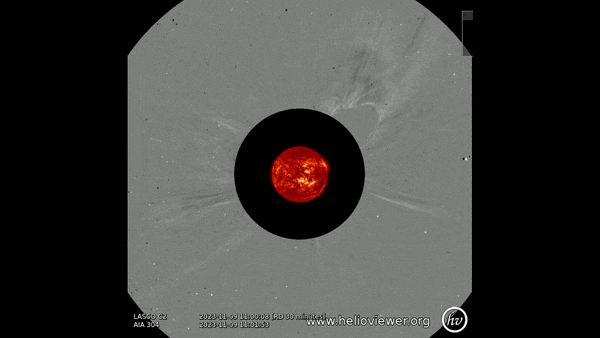Geomagnetic storm forecast - 10th November 2023
What Has Happened?
We are expecting an increase in geomagnetic activity during 11th and 12th November due to the arrival of an Earth-directed coronal mass ejection.
A full halo Coronal Mass Ejection (CME) left the Sun at approximately 10:50 UT on 9th November 2023, associated with a filament eruption from an Earth-facing active region on the sun. The CME is expected to arrive late on 11th November and is likely to lead to a significant enhancement in geomagnetic activity, making moderate geomagnetic STORM periods possible. The current solar wind speed is already disturbed due to coronal hole influence.
Assuming clear dark skies, there is an increased chance of seeing the aurora tomorrow evening and on 12th November. Those in Scotland, northern England and Northern Ireland have the best chance if the weather is favourable.
Sign-up to receive Geomagnetic Disturbance Alert emails.
Follow us on Twitter:
Follow @BGSauroraAlert for more occasional aurora alerts.
Follow @BGSspaceWeather for daily space weather forecasts.
Glossary
- BGS
- The British Geological Survey is a geoscience research centre that is part of UK Research and Innovation (UKRI) and affiliated to the Natural Environment Research Council (NERC).
- CME or Coronal Mass Ejection
- The eruption of a portion of the outer atmosphere of the Sun into space, caused by rapid changes in its magnetic field. Often occurs along with a solar flare.
- Solar Wind
- The ever-present expansion of the Sun’s hot outer atmosphere into the solar system, which carries space weather within it.
- Coronal Hole
- A region in the Sun’s outer atmosphere (corona) where hot material can flow unrestrained by its magnetic fields out into space.
- Filament Eruption
- An eruption of solar plasma (i.e. ions and electrons) associated with the upward movement of solar magnetic field lines into the corona. Filaments are usually dark against the bright solar disk but can appear bright (as 'erupting prominences') on the limbs of the Sun against the darkness of space. Filaments are often associated with CMEs
- Sunspot/Active Region
- A region of intense magnetic field in the Sun's visible outer atmosphere often associated with flares and CMEs.


